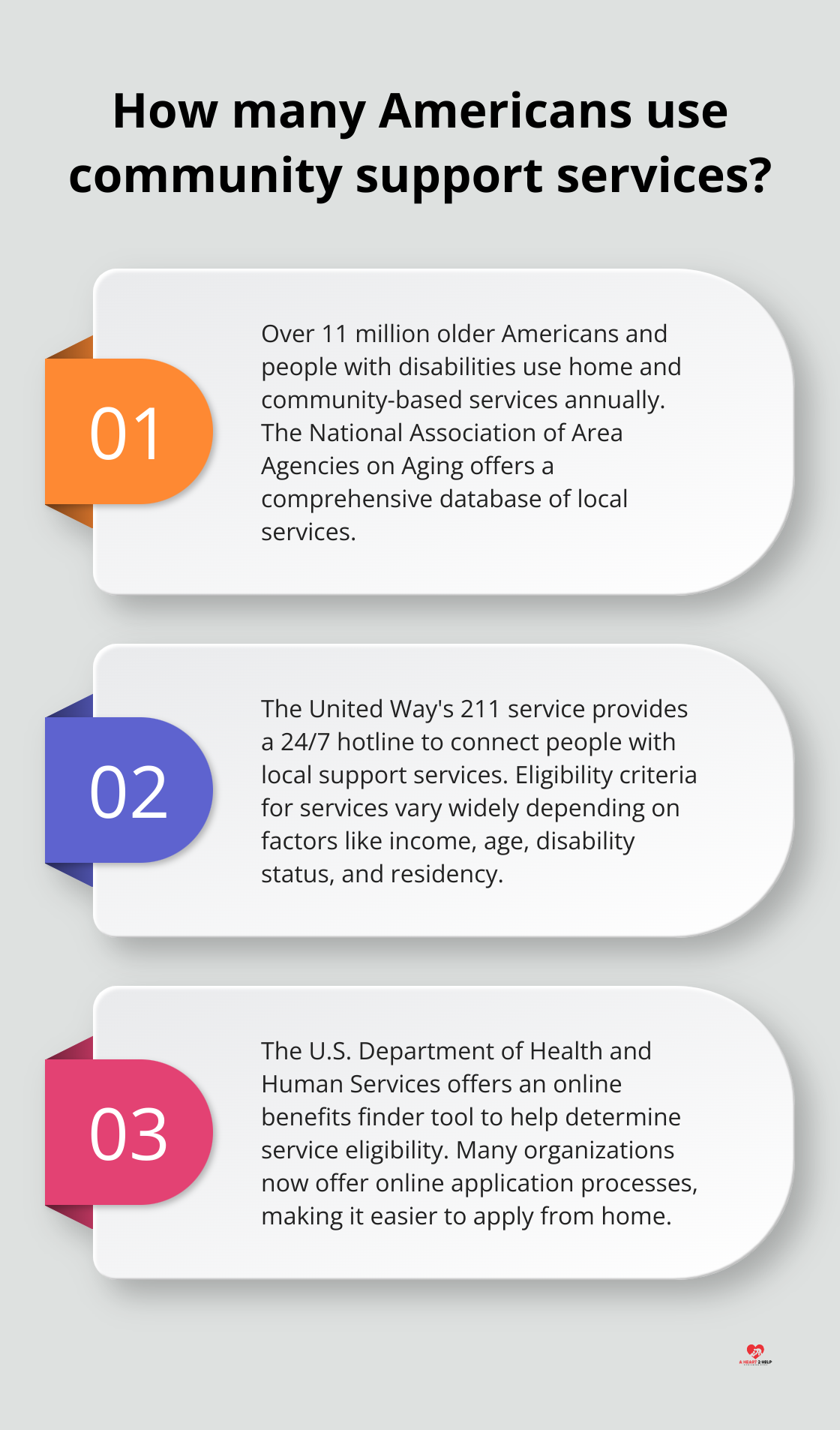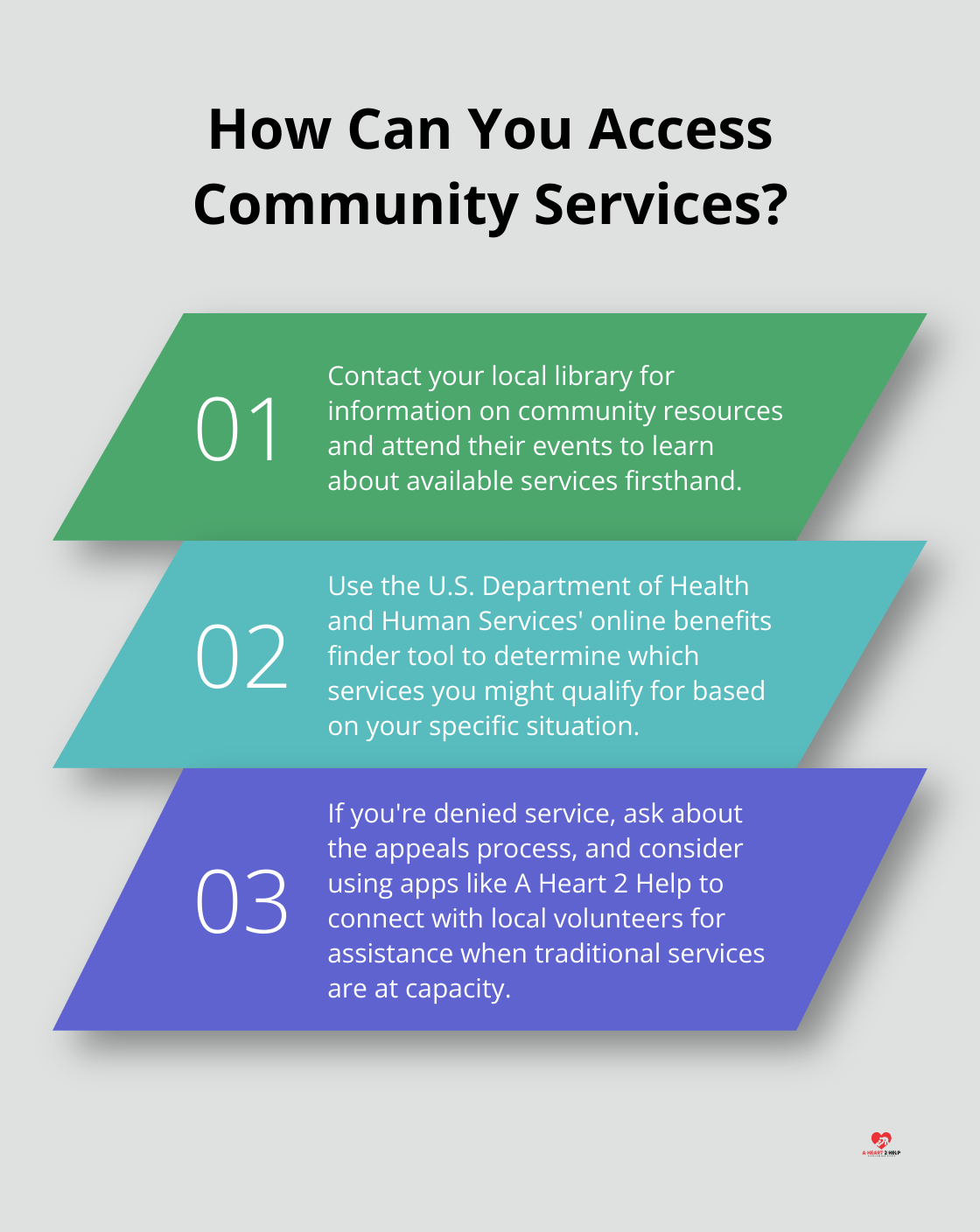Community support services are the backbone of a thriving society. These vital programs provide assistance to individuals and families facing various challenges, from mental health issues to disability support.
At A Heart 2 Help, we’ve seen firsthand how understanding the meaning of community support services can transform lives. This blog post will explore the types of services available, their benefits, and how to access them effectively.
Types of Community Support Services
Community support services form the foundation of a thriving society. These essential programs provide assistance to individuals and families facing various challenges. Let’s explore the main types of support available.
Mental Health Support
Mental health services play a vital role in today’s fast-paced world. These include counseling, therapy sessions, and support groups. Many communities now offer 24/7 crisis hotlines. The National Alliance on Mental Illness (NAMI) reports that 1 in 5 U.S. adults experience mental illness each year, while 1 in 20 U.S. adults experience serious mental illness each year. Local mental health centers often provide sliding scale fees, which makes help accessible to more people.
Elderly Care Services
As our population ages, elderly care services become increasingly important. These range from in-home care to adult day centers. Meals on Wheels America serves over 2.4 million seniors annually, providing not just food but also social interaction. Senior centers offer activities and social opportunities, combating isolation (which affects 1 in 4 older adults according to the CDC).
Youth and Family Programs
Programs for youth and families focus on education, recreation, and support. After-school programs have shown to improve academic performance by 12% (according to a study by the Afterschool Alliance). Family counseling services help strengthen relationships and navigate challenges. Many communities also offer parenting classes and support groups for new parents.
Disability Support Services
These services aim to improve the quality of life for individuals with disabilities. They include occupational therapy, assistive technology, and job training programs. According to recent data, the employment rate for U.S. persons with a disability was 17.9% in 2020, down from 19.3% in 2019, which highlights the need for more robust support systems.
Addiction Recovery Programs
Addiction recovery services provide a lifeline for those struggling with substance abuse. These include detox facilities, inpatient and outpatient treatment, and support groups like Alcoholics Anonymous. The Substance Abuse and Mental Health Services Administration (SAMHSA) reports that in 2019, 20.4 million Americans aged 12 or older had a substance use disorder, which underscores the critical need for these services.

While traditional support services remain invaluable, technology also plays an increasing role. Apps like A Heart 2 Help revolutionize how we connect those in need with those who can help, making community support more accessible than ever before.
Now that we’ve explored the types of community support services, let’s examine the numerous benefits these services provide to individuals and communities alike.
How Community Support Services Benefit Society
Community support services offer far-reaching benefits that extend beyond individual recipients to positively impact entire communities. These services create a ripple effect of positive change, improving lives and strengthening social fabric in numerous ways.
Enhanced Individual Well-being
Community support services significantly improve the quality of life for those who use them. According to the National Institute of Mental Health, statistics on the prevalence, treatment, and costs of mental illness for the population of the United States are available, highlighting the importance of mental health services in enhancing individual well-being.
Stronger Social Bonds
These services foster stronger social connections, which are essential for overall well-being. Community centers and support groups provide platforms for people to connect, share experiences, and build lasting relationships.
Reduced Healthcare System Pressure
Preventive care and early intervention significantly reduce the burden on healthcare systems. According to the Centers for Disease Control and Prevention, 90% of the nation’s $4.5 trillion in annual health care expenditures are for people with chronic and mental health conditions. This underscores the importance of community support services in reducing healthcare system pressure.
Economic Growth
The economic impact of community support services is substantial. These services create jobs, stimulate local spending, and attract investment. Moreover, when individuals receive the support they need, they remain productive members of the workforce, further contributing to economic growth.
Resilient Communities
Community support services play a key role in disaster preparedness and response. During crises, these established networks quickly mobilize resources and provide essential aid.

Community support services address various social needs, creating a more inclusive, healthy, and prosperous society for all. As we recognize their value, it’s important to support and expand these services. But how can individuals access these vital resources? Let’s explore the process of finding and utilizing community support services in the next section.
How to Access Community Support Services
Finding Local Services
Start your search with online directories. The National Association of Area Agencies on Aging offers a comprehensive database of local services. Enter your zip code or city and state to find nearby resources. The United Way’s 211 service (available in many areas) provides a 24/7 hotline to connect you with local support services.

Your local library serves as an excellent resource. Librarians often possess extensive knowledge about community resources and can direct you effectively. Many libraries host community events where you can learn about available services firsthand.
Social media platforms prove powerful for discovering local services. Join community Facebook groups or follow local non-profits on Twitter or Instagram. These channels frequently share information about upcoming events, new programs, and available resources.
Understanding Eligibility and Application Processes
Eligibility criteria vary widely depending on the service and your location. Factors like income, age, disability status, and residency typically influence eligibility. The U.S. Department of Health and Human Services offers an online benefits finder tool to help you determine which services you might qualify for based on your specific situation.
When you apply for services, prepare to provide documentation. This often includes proof of income, identification, and residency. Many organizations now offer online application processes (making it easier to apply from home). If you feel uncomfortable with technology, ask for in-person assistance.
Overcoming Access Barriers
Language barriers can impede access to services. Look for organizations that offer multilingual services if English isn’t your first language. Many community centers provide translation services or employ staff who speak multiple languages.
Transportation issues can hinder access to services. Check if your local area offers reduced-fare public transportation for seniors or individuals with disabilities. Some community support services provide assistance with everyday activities and help make it possible for many people with disabilities and older adults to live in their communities.
For those with disabilities, ensure that the services you consider are accessible. The Americans with Disabilities Act requires many service providers to offer reasonable accommodations. Ask about specific accommodations you might need.
If you struggle to navigate the system, seek help from a case manager or social worker. These professionals can guide you through the process, help you understand your options, and advocate on your behalf.
If a service denies your application, ask about the appeals process. Many organizations have procedures in place for reconsidering applications.
Consider using technology to your advantage. Apps like A Heart 2 Help connect you with local volunteers who can assist with various needs (from transportation to companionship). This proves particularly helpful when traditional services reach capacity or have long waiting lists.
Final Thoughts
Community support services form the bedrock of a thriving society. These services offer vital assistance to individuals and families facing diverse challenges, enhancing the quality of life for countless people. The meaning of community support services extends beyond mere assistance; it embodies the essence of a caring, interconnected community.

Technology revolutionizes how we access and deliver community support. A Heart 2 Help bridges gaps between those in need and those willing to help, making volunteering more accessible. This innovative care-app connects compassionate individuals with people requiring assistance, fostering a sense of community through real-time support.
The importance of community involvement in supporting these services cannot be overstated. Each of us has the power to contribute to the well-being of our communities through volunteering, donating, or spreading awareness. Strong communities are built on mutual support and understanding, creating a network that uplifts everyone.
